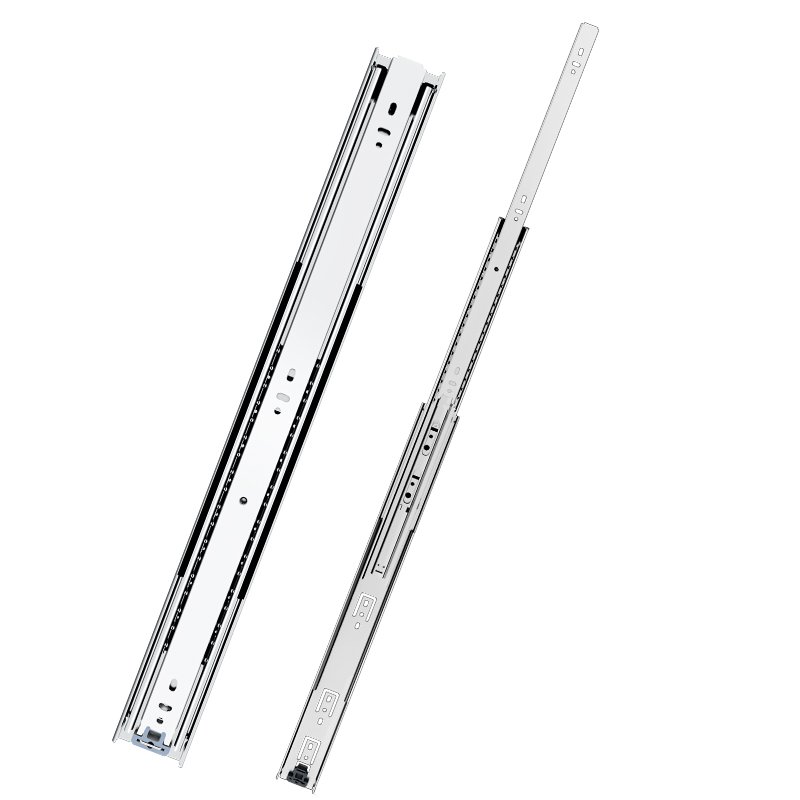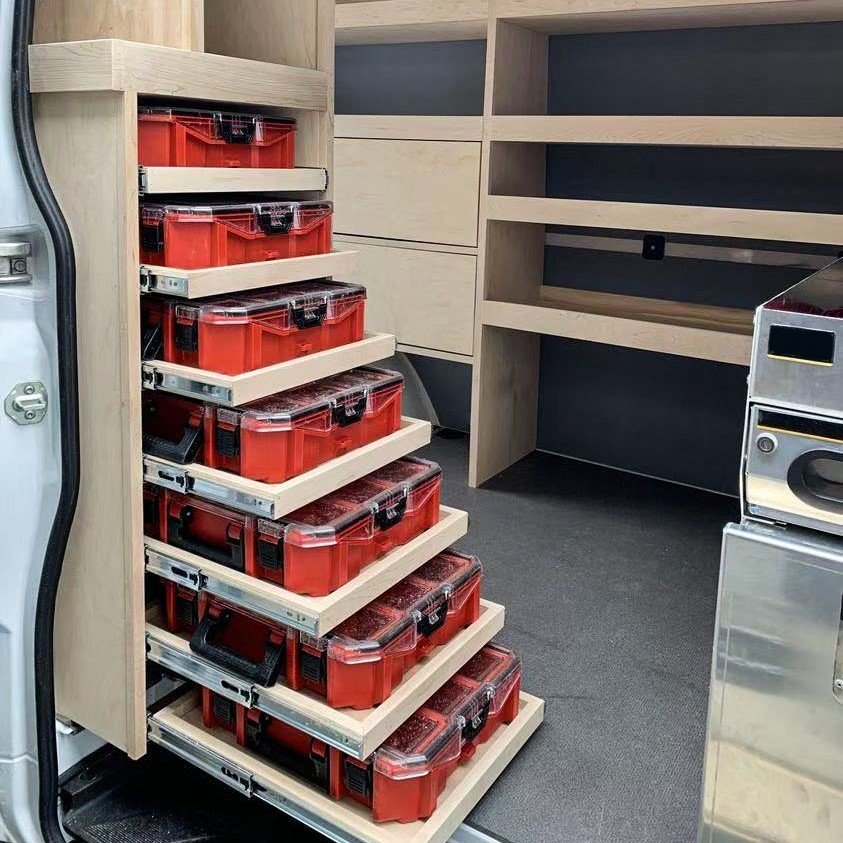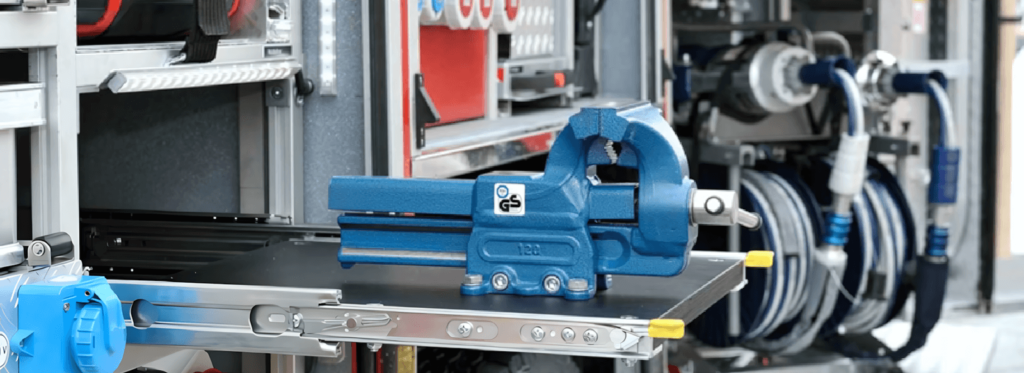heavy duty drawer slides
Looking for a different size or weight capacity? Click below to discover our full range of heavy-duty drawer slides that perfectly fit your needs!

Heavy Duty Drawer Slides - A5115
150 lbs
Material: Cold-rolled steel/Q235
Slide width: 51mm
Installation thickness: 13±0.5mm
Slide length: 10″ to 40″
Load bearing: 18“150 lbs (68kg)
Level of travel: Full Extension
Mounting type: Side Mount
Customizable heavy duty drawer slides size, function, hole position, color, etc.
Application Segment
vehicle modification, industrial storage, medical equipment storage, electronic products, etc.


Our Services
MOQ Offered
We provide flexible minimum order quantities, allowing you to start small and scale up as needed.
Large Inventory
Ensuring Ample Stock for Immediate Shipment, Eliminating Wait Times for Production.
Complete Specifications
We refine various specifications of drawer slides according to different usage scenarios.
AOLISHENG produces heavy duty drawer slides with standard specifications and provides customized solutions to meet your project needs.
Why Choose AOLISHENG
Rich Experience
- 15 years of industry experience.
- Extensive customization experience.
Production Automation
- Over 90% automation in production.
- Production efficiency increased by more than 10 times.
Quality Assurance
- High-quality products certified with SGS and EN standards.
- Stringent inspection department.
Mass Production
- Factory area of over 40,000 square meters.
- Daily production capacity of over 100,000 sets.
Leading Quality
- Hundreds of professional production machines.
- 5 times product accuracy.
We Look Forward To Your Contact
AOLISHENG is your trusted global partner for high-quality drawer slide production, with strategic factories worldwide and professional local service teams. Partnering with AOLISHENG ensures efficient project delivery, robust supply chains, expert technical support, and a thriving customer base.
FAQ
What is the best way to move heavy furniture by yourself?
Moving heavy furniture on your own can be very challenging, but by using the right tools and techniques, the process can be made safer and more efficient. Here are some of the best methods and tips:
1. Use furniture gliders
Sliders: Place furniture sliders on the bottom of your furniture. These sliders, usually made of plastic, rubber, or fiber, can significantly reduce friction and make the furniture slide more easily.
DIY sliding mat: If you don’t have a ready-made sliding mat, you can use an old towel, cardboard, or foam pad as a temporary sliding mat.
2. Use the Leverage Principle
Crowbar or crowbar: Use a crowbar to gently lift one end of the furniture. Place a sliding pad or small block of wood under the raised end and move the other end.
Wood Blocks: Place a few small wood blocks or bricks under the furniture and move it a little at a time so that the furniture always maintains a certain height during the move and moves gradually.
3. Use furniture moving straps
Moving straps: Place furniture moving straps around the sides of the base of the furniture and use the straps to lift the sides of the furniture. This type of strap helps you better distribute weight and reduces direct stress on your body.
Shoulder Straps: Use specialized shoulder straps to lift and move furniture, giving you better control over heavy objects.
4. Pulleys and carts
Furniture casters: If the furniture can have casters attached to its base, use furniture casters to slide the furniture around easily. The pulley system allows you to move heavy objects easily on the ground.
Trolley: Use a wheeled trolley to place furniture on. The trolley can help you move heavy items easily.
5. Lubricate the floor
Soapy water: Spray some soapy water on the floor to reduce friction and make furniture slide more easily. Make sure the floor is dry to prevent slipping.
Silicone: Use a silicone spray to create a sliding layer between the base of your furniture and the floor.
6. Move gradually
Stage: Lift one end of the furniture and place a slide or small block of wood to move it gradually. You can move part of the furniture first before proceeding to the next step.
7. Protect the floor
Protective pads: Lay protective pads, blankets, or cloths on the floor to prevent furniture from scratching the floor during movement.
Check the condition of the floor: Make sure there are no protruding nails or debris on the floor that could prevent the furniture from sliding.
8. Dress appropriately
Wear appropriate clothing: Wear comfortable and supportive clothing, avoid clothing that is too loose, and ensure it does not interfere with your activities while moving.
9. Physical strength and skills
Maintain good posture: When lifting furniture, keep your back upright and use your legs instead of just your waist. Avoid bending or twisting to reduce the risk of injury.
Move in small steps: Move furniture in small steps and maintain even pressure to ensure stability and control.
10. Ask for help
Ask for assistance: While these tips can help you move furniture on your own, if the furniture is too heavy or unwieldy, consider enlisting the help of a friend or neighbor to ensure safety.
Summarize
When it comes to moving heavy furniture alone, using tools like sliding mats, moving straps, pulleys, and dollies can make the task easier. Also, lubricating floors, moving furniture gradually, protecting floors, and proper dress and posture are all key factors. Through these methods, you can increase moving efficiency and reduce damage to floors and furniture.
How to make drawer slides smoother?
To make the drawer slides smoother, you can follow these steps:
1. Clean the drawer slides
Remove the drawer: First, remove the drawer from the cabinet to facilitate cleaning.
Clean the drawer slides: Use a clean cloth, soft brush, or vacuum cleaner to remove dust and debris from the drawer slides. Make sure the drawer slides are clean inside and outside to avoid dirt affecting the sliding effect.
2. Lubricate the drawer slides
Choose a lubricant: Use a lubricant suitable for drawer slides, such as silicone oil, graphite powder, or a special slide lubricant. Avoid using grease or water-containing lubricants because they may attract dust.
Apply lubricant: Spray or apply lubricant evenly on the contact surface of the drawer slides. Lubricate each part of the drawer slides to ensure that the lubricant is evenly distributed.
Slide the drawer: Install the drawer back into the cabinet and slide it back and forth several times to evenly distribute the lubricant on the drawer slides.
3. Check the alignment of the drawer slides
Check the alignment: Make sure the drawer slides are installed correctly and the drawers are aligned on the drawer slides. Misaligned drawer slides will cause the drawer to slide unevenly.
Adjustment screws: Check the rail’s fixing screws to make sure they are tight in place. If the rail has adjustment screws, you can make fine adjustments as needed.
4. Check the wear of the drawer slides and drawers
Check for wear: Check the contact surface of the drawer slides and drawers for obvious wear. If the drawer slides or drawer components are severely worn, they may need to be replaced or repaired.
Replacement parts: If you find that the drawer slides or drawer components are severely worn, consider replacing new drawer slides or repairing the drawers.
5. Check the load
Evenly distribute the load: Make sure the items in the drawer are evenly distributed to avoid excessive weight on one side. This can prevent the drawer slides from sliding difficulty due to uneven load.
6. Check the drawer installation
Check for sticking: Check if the drawer is stuck when opening and closing, and make sure there are no objects or structures that hinder sliding.
Adjust the installation position: If the drawer is stuck, check whether the drawer slides need to be adjusted or reinstalled.
7. Regular maintenance
Regular cleaning and lubrication: To keep the rails smooth, it is recommended to clean and lubricate the drawer slides regularly to avoid the accumulation of dust and dirt.
How much gap do you leave for drawer slides?
When installing drawer slides, leaving the right gap is key to ensuring smooth sliding and proper drawer operation. Generally, the gap between the slide and the drawer or cabinet should be set according to the following standards:
1. Horizontal gap (slide to drawer side):
Recommended gap: Usually leave 1/16 to 1/8 inch (about 1.5 to 3 mm) of gap on each side. This gap is enough to accommodate the rollers or rails of the slide, allowing it to slide smoothly without getting stuck.
Why: A proper gap can prevent the drawer from getting stuck due to friction when sliding, and avoid wear caused by the slide being too close to the drawer side.
2. Vertical gap (drawer and cabinet upper and lower edges):
Recommended gap: Usually leave 1/8 to 1/4 inch (about 3 to 6 mm) of gap above and below. This gap helps ensure that the drawer can slide in and out smoothly while avoiding collisions with the cabinet edges.
Why: A vertical gap helps prevent the drawer from getting stuck or squeezed due to gravity or overhang and can accommodate possible expansion or contraction.
3. Check the type of slide:
Sliding method: Different types of slides (such as ball bearing slides, and slider slides) may have different installation clearance requirements. Before installation, you should refer to the slide manufacturer’s recommendations.
Self-adjusting slides: Some slides are designed with self-adjustment functions, which can tolerate larger installation errors, but it is still recommended to follow the manufacturer’s installation instructions.
4. Actual adjustment:
Test sliding: During the installation process, it is recommended to perform a sliding test after the slides and drawers are installed. Fine-tune according to the actual sliding conditions to ensure that the drawers can open and close smoothly in various states.
Through these gap settings, it can be ensured that the drawer slides are not subject to friction and interference during normal use, thereby improving the service life and smooth operation of the drawers.
How to tell if a heavy duty drawer slides are damaged?
Suppose the heavy duty drawer slides are not smooth or stuck when opening and closing the drawer, or are bent, loose, or make unusual noises. In that case, it may mean that the heavy duty drawer slides are damaged and need to be replaced or repaired.
Are heavy duty drawer slides complicated to install?
The ease of installation depends on the type of heavy-duty drawer slide and the application scenario. Side-mounted heavy duty drawer slides and bottom-mounted heavy duty drawer slides are usually simpler and can be fixed to the drawer and cabinet with screws. Concealed slides and some special industrial slides are slightly more difficult to install and may require professional tools or the assistance of experienced technicians.
What factors should be considered when choosing heavy duty drawer slides?
When choosing heavy duty drawer slides, pay attention to the following points:
- Load capacity: Make sure the heavy duty drawer slides have the load capacity you need.
- Length: Choose the appropriate slide length based on the depth of the drawer.
- Expandability: The full-extension and two-thirds-extension types of heavy duty drawer slides determine how far the drawer can be pulled out.
- Material and corrosion resistance: Consider whether you need corrosion-resistant materials such as stainless steel or galvanizing, especially in humid environments.
- Smoothness of sliding: Choose heavy duty drawer slides with ball bearings to improve the smoothness of opening and closing.
What are the standard lengths for heavy duty drawer slides?
Heavy duty drawer slides are typically available in lengths ranging from 10 inches (about 25 cm) to 60 inches (about 150 cm). The length you choose should match the depth of the drawer to ensure that the drawer can be fully extended or partially extended as required.
